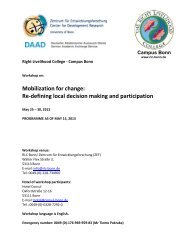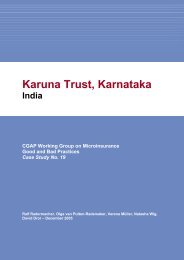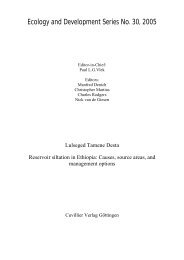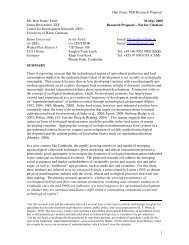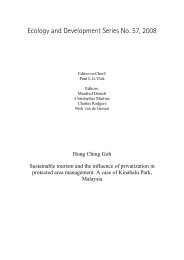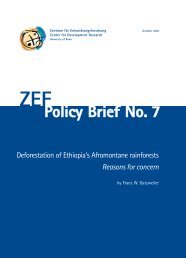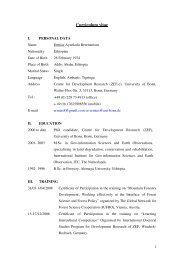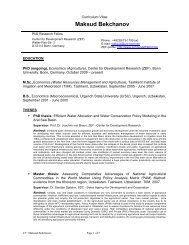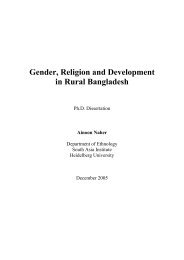Ecology and Development Series No. 10, 2003 - ZEF
Ecology and Development Series No. 10, 2003 - ZEF
Ecology and Development Series No. 10, 2003 - ZEF
- No tags were found...
Create successful ePaper yourself
Turn your PDF publications into a flip-book with our unique Google optimized e-Paper software.
Floristic analysis of the undisturbed forestconservation of wild Coffea arabica populations. Two major reasons supporting theproposition are: (1) the status of the wild coffee populations; <strong>and</strong> (2) the floristic diversityof the forest.Firstly, the study revealed that C. arabica is one of the most abundant plantspecies in the forest. In the preliminary study by Demel et al. (1998), only the presence ofwild population was reported, <strong>and</strong> the pattern <strong>and</strong> extent of distribution of C. arabica in theforest was investigated. This study presents precise data which shows that coffee is indeedvery abundant <strong>and</strong> widely distributed in the forests (Table 4.1). It occurs in most parts ofthe forest (in about 91% of the plots; Table 4.1), <strong>and</strong> is the most abundant <strong>and</strong> bestindicator species of a plant community type (Group 1). The forest in general has the highestabundance of wild coffee stems compared to all other similar forests studied to date (e.g.,Harrena forest, Mesfin <strong>and</strong> Lisanework 1996; Bonga forest, Abayneh 1998). Within theforest l<strong>and</strong>scape of Yayu, sections of the forest at higher altitudes <strong>and</strong> on flat to gentleslopes are more suitable for coffee. However, such areas are also suitable for agriculturalproduction <strong>and</strong> human settlement, <strong>and</strong> hence are prone to deforestation. For this reason,only few such forest areas with wild coffee populations remain in the country, covering atotal area of less than 2000 km 2 (Tewolde 1990). The fact that there is still large area ofintact forest at Yayu can be attributed to two reasons: the economic value of the wild coffeefor the livelihood of the local community <strong>and</strong> the topography of the l<strong>and</strong>scape. Coffeeproduction is the major source of income for the majority of the local population (ca. 60%,Tafesse 1996). Coffee is harvested either directly from the wild plants in the undisturbedforest or from traditionally managed forests in the area. The topography of the area is alsodifficult for other types of agricultural practices. The area is characterized by a rollingtopography, highly dissected by valleys of small streams with some flat to gentle slopes onthe ridges in between valleys. These can positively contribute for the long termconservation of the wild coffee population in the forest while sustainably using it, as longas coffee production is economically viable <strong>and</strong> appropriate arrangements for suchmanagement are put in place by the government. More discussion on such issues is found inchapter 6 of this dissertation.63



